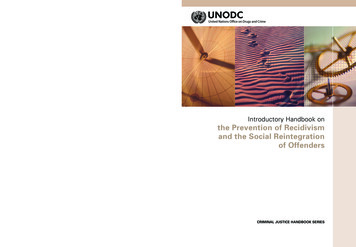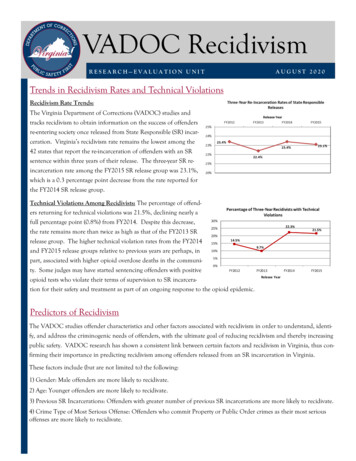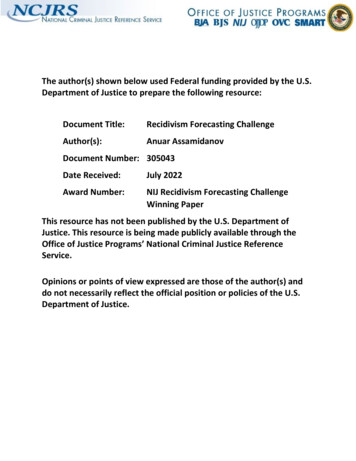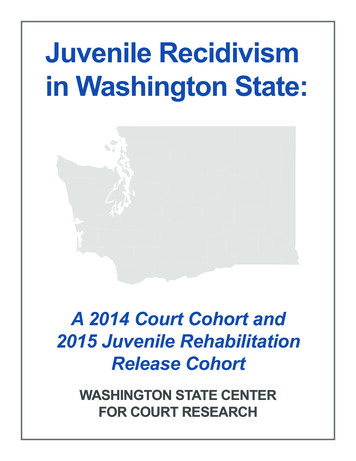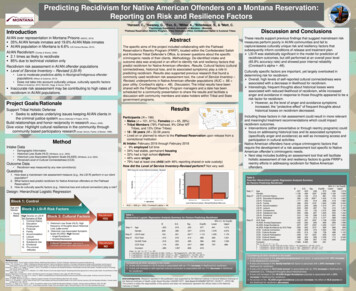
Transcription
Predicting Recidivism for Native American Offenders on a Montana Reservation:Reporting on Risk and Resilience Factors1Hansen,C., 1Swaney, G., 1Fox, D., 2Miller, A., 2Billedeaux, S., & 2Matt, C.Department, University of Montana – Missoula2Flathead Reservation Reentry Program, Tribal Defenders Office, Confederated Salish & Kootenai Tribes1PsychologyIntroductionAI/AN over representation in Montana Prisons (MDOC, 2015) 35% AI/AN female inmates and 19.6% AI/AN Male inmates AI/AN population in Montana is 6.6% (US Census Bureau, 2015).AI/AN Recidivism (Conley & Shantz, 2006) 2.1 times as likely to recidivate 85% due to technical violation onlyRecidivism risk assessment in AI/AN offender populations Level of Service Inventory – Revised (LSI-R) Low to moderate predictive ability in Aboriginal/Indigenous offenderpopulations (Wilson & Gutierrez, 2013) Does not take into account culturally unique, culturally specific factors(Wilson & Gutierrez, 2013; Wormith, Hogg, & Guzzo, 2015) Inaccurate risk assessment may be contributing to high rates ofrecidivism in AI/AN populations.AbstractThe specific aims of this project included collaborating with the FlatheadReservation’s Reentry Program (FRRP), located within the Confederated Salishand Kootenai Tribal Defender’s Office, to answer questions about the specificcriminogenic needs of their clients. Methodology. De-identified intake andoutcome data was analyzed in an effort to identify risk and resiliency factors thatpredict recidivism for Native American offenders. Results. Cultural factors (culturalconnectedness, historical loss, and its associated symptoms) play a role inpredicting recidivism. Results also supported previous research that found acommonly used recidivism risk assessment tool, the Level of Service Inventory –Revised, underperforms in Native American offender populations (AUC .66 poor utility; Cronbach's alpha .48). Discussion. The initial results have beenshared with the Flathead Reentry Program managers and a date has beenscheduled for a community presentation to share the results and facilitate adiscussion with community members and stake holders within Tribal and Stategovernment programs.Project Goals/RationaleSupport Tribal Holistic Defense Seeks to address underlying issues keeping AI/AN clients inthe criminal justice system (Bronx Defender’s Project, 2010).Build relationships and honor reciprocity in research (Wilson, 2009).Give voice: Highlight cultural resilience in the community throughcommunity based participatory research (Israel, Schulz, Parker, & Becker, 1998).MethodIntake Data Demographic InformationHistorical Loss Scale (HLS) (Whitbeck, et al., 2004)Historical Loss Associated Symptom Scale (HLASS) (Whitbeck, et al. 2004)Perceived Level of Cultural Connectedness (CCS)Outcome Data Recidivism was measured by any new conviction(s)ResultsParticipants (N 166) Males (n 101, 61%), Females (n 65, 39%) Tribal Members (78% Flathead, 9% Other MTTribes, and 13% Other Tribes) 18 - 58 years (M 33.56 years) Lived on or planned to return to the Flathead Reservation upon release from acorrectional InstitutionAt Intake: February 2016 through February 2018 9% employed full time 34% had stable, permanent housing 32% had a high school diploma 46% were single 79% had at least one child (with 46% reporting shared or sole custody)How did the Level of Service Inventory-Revised perform? Not very well.Discussion and ConclusionsThese results support previous findings that suggest mainstream riskmeasures perform poorly in AI/AN communities and fail tocapture/assess culturally unique risk and resiliency factors thatsubsequently inform conditions of release and treatment plan. LSI-R was statistically significant in the model for prediction ofrecidivism outcomes, but still performed at an overall poor level(65.8% accuracy rate) and showed poor internal reliability(Cronbach’s alpha .48).Culturally specific factors are important, yet largely overlooked indetermining risk for recidivism. Overall, high levels of self-reported cultural connectedness wereassociated with a decrease in likelihood for recidivism. Interestingly, frequent thoughts about historical losses wereassociated with reduced likelihood of recidivism, while increasedanger and avoidance in response to those thoughts appeared to be arisk factor for recidivism. However, as the level of anger and avoidance symptomsincreased, the “protective effect” of frequent thoughts abouthistorical losses on recidivism decreased.Including these factors in risk assessment could result in more relevantand meaningful treatment recommendations which could impactrecidivism outcomes. Interventions (either preventative or through reentry programs) couldfocus on addressing historical loss and its associated symptoms(specifically anger and avoidance) as well as increasing access andparticipation in cultural activities.Native American offenders have unique criminogenic factors thatrequire the development of a risk assessment tool specific to NativeAmerican offender’s criminogenic needs. Next step includes building an assessment tool that will facilitateholistic assessment of risk and resiliency factors to guide FRRP’sreentry efforts in addressing recidivism for Native Americanoffenders.Questions1. How does a mainstream risk assessment measure (e.g., the LSI-R) perform in our clientpopulation?2. What factors best predict recidivism for Native American offenders on the FlatheadReservation?3. How do culturally specific factors (e.g., historical loss and cultural connection) play a role?Table 2.Post-Hoc Hierarchical Logistic Regression Analysis Summaryfor Factors Predicting RecidivismBDesign: Hierarchical Logistic RegressionStep 1aStep 2b RecidivismYESAUC .658 (p .002), Cronbach’s alpha .48Table 1.Hierarchical Logistic Regression Analysis Summary for Factors Predicting RecidivismBS.E.Sig.Exp(B)95% C.I. for r.839.390.031*2.3151.0784.973Step 2bLSI-R total.104.031.001**1.1101.0451.179Step 3cHLS Total-.015.018.414.985.9501.021HLASS Total-.016.023.490.984.9401.030CCS 806.619Step 1aRecidivismNONotes. *p .05, **p .01, *** p .001.a. -2 log likelihood 212.367, model χ2(2, N 166) 3.678, p .159, Nagelkerke R .030, PAC 64.5%b. -2 log likelihood 197.818, model χ2(3, N 166) 18.227, p .000***, Nagelkerke R .143, PAC 68.1%c. -2 log likelihood 192.590, model χ2(6, N 166) 23.456, p .001**, Nagelkerke R .181, PAC 69.3%ReferencesBronx Project (2010). The four pillars of Holistic Defense, Redefining Public Defense, The Bronx Defenders. Retrieved from www.bronxdefenders.orgConley, T. B., & Schantz, D. L. (2006). Predicting and reducing recidivism: Factors contributing to recidivism in the state of Montana pre-release center population and the issue ofmeasurement: A report with recommendations for policy change. On file with the Montana Department of Corrections and The University of Montana School of Social Work.Gutierrez, L., Wilson, H. A., Rugge, T., & Bonta, J. (2013). The prediction of recidivism with Aboriginal offenders: A theoretically-informed meta-analysis. Canadian Journal of Criminologyand Criminal Justice, 55, 55-99Israel, B. A., Schulz, A. J., Parker, E. A., & Becker, A. B. (1998). Review of community-based research: Assessing partnership approaches to improve public health. Annual Review of PublicHealth, 19(1), 173-202.Montana Department of Corrections. (2015). 2015 Biennial report to the people of Montana. Deer Lodge, MT: MCE Print Shop.Whitbeck, L. B., Adams, G. W., Hoyt, D. R., & Chen, X. (2004). Conceptualizing and measuring historical trauma among American Indian people. American Journal of CommunityPsychology, 33(3-4), 119-130.Wilson, S. (2009). Research is ceremony: Indigenous research methods, Fernwood Publishing, Black Point, NS, Canada.Wilson, H. A., & Gutierrez, L. (2013). Does one size fit all? A meta-analysis examining the predictive ability of the Level of Service Inventory (LSI) with Aboriginal offenders. Criminal Justiceand Behavior, 41(2), 196-219.Wormith, J. S., Hogg, S. M., & Guzzo, L. (2015). The predictive validity of the LS/CMI with Aboriginal offenders in Canada. Criminal Justice and Behavior, 42(5), 481-508.United States Census Bureau. (2015, July 1). United States quickfacts: People: Race and Hispanic origins. Retrieved August 6, 2016, from http://quickfacts.census.govConsidering all other variables in the model: A one unit increase in LSI-R scores is associated with an 11% increase in likelihood for recidivism A one unit increase in self-reported cultural connection is associated with an 11% decrease in likelihoodfor recidivismAcknowledgments. Research reported in this publication was supported by the National Institute of General Medical Sciences ofthe National Institutes of Health under Award Number U54GM115371, Sub-Award #1U54GM11537101 (10/16/17 – 07/31/18).The content is solely the responsibility of the authors and does not necessarily represent the official views of the NationalInstitutes of Health.Step 3cAgeGenderLSI-R: Criminal HistoryLSI-R: Education/EmploymentLSI-R: FinancialLSI-R: FamilyLSI-R: AccommodationLSI-R: LeisureLSI-R: CompanionsLSI-R: Substance UseLSI-R: EmotionalLSI-R: AttitudesHLS TotalHLASS: Anxiety/DepressionHLASS: Anger/AvoidanceHLASS: Anger/Avoidance by HLS TotalCCS: Cultural ConnectionCCS: Cultural AccessCCS: Cultural ParticipationCCS: Cultural DesireCCS: Cultural 1423.483.029.00195% C.I. for 6352.053Note, *p .05, **p .01, *** p .001.a. -2 log likelihood 212.367, model χ2(2, N 166) 3.678, p .159, Nagelkerke R .030, PAC 64.5%b. -2 log likelihood 180.834, model χ2(12, N 166) 35.212, p .000***, Nagelkerke R .263, PAC 71.7%c. -2 log likelihood 166.097, model χ2(21, N 166) 49.948, p .000**, Nagelkerke R .357, PAC 73.5%Considering all other variables in the model: A one unit increase in the education/employment risk factor is associated with 43% increasein the likelihood for recidivism A one unit increase in the family/marital risk factor is associate with a 64% increase in thelikelihood for recidivism. A one unit increase in HLS total scores* is associated with an 11% increase in likelihood forrecidivism (i.e., *infrequent thoughts about historical loss) A one unit increase in the HLASS-Anger/Avoidance subscale is associated with a 23%increase in likelihood for recidivism. As scores on the HLASS-anger/avoidance subscale increase, the effect of HLS scores onthe likelihood for recidivism decreases.
RTJUESTABLISHED 1969ATCOUIONNNA TIONDIAINAMERIC A NLADGES ASSOCICollateral ConsequencesThrough the use of two infographics, these publications are intended toprovide general information about collateral consequences that result fromconvictions and/or incarceration. These publications should be used as thefirst general step on the path to identifying specific solutions to collateralconsequences in tribal communities.ONE OFFENSE CAN TRIGGER MULTIPLE COLLATERAL CONSEQUENCES.BRIA L H O U SINCIV ILRIG H TGTTribal Justice SystemCULT U R A LLICFA M ILYLOY M E NTPEMENSINGThis project was supported by Grant No. 2011-AL-BX-K002 awarded by the Bureau of Justice Assistance. The Bureau of Justice Assistance is a component of theDepartment of Justice’s Office of Justice Programs, which also includes the Bureau of Justice Statistics, the National Institute of Justice, the Office of Juvenile andDelinquency Prevention, the Office for Victims of Crime, and the Office of Sex Offender Sentencing, Monitoring, Apprehending, Registering, and Tracking. Points ofview or opinions in this publication are those of the author and do not necessarily represent the official position or policies of the U.S. Department of Justice.S
Collateral ConsequencesIn most tribal jurisdictions, one offense can trigger multiple collateral consequences. Collateralconsequences are the continuing and lasting impacts of being charged or convicted of a crime inthe tribal justice system (hereinafter “tribal court”). Collateral consequences arise in the aftermathof the direct consequence and are not always immediately obvious to those affected.Tribal HousingBeing charged or convicted of a crime can affect eligibility to benefit from tribalhousing programs and services. Tribal housing authorities have broad discretion toevict individuals who are viewed as a threat to the health or safety of the community.What seems like a minor infraction of the law (e.g. drug possession or non-violentmisdemeanor) may lead to major consequences, including eviction.CulturalMany tribes have the authority under tribal law to banish individuals for committingcrimes. If the individual is a member of the banishing tribe, this results in theseparation of the individual from ceremonies, festivities, and tribal gatherings.FamilyTribal court convictions may result in jail time. No matter the amount of time behindbars, a family member serving time affects the entire family unit and sometimesextended family (e.g., a grandparent). Both children and spouses suffer, as theabsence of the family member impacts familial relationships and everyday life.Tribal court convictions, especially those stemming from drug and alcohol offenses, canalso impact child custody. A parent convicted of a drug offense may have their parentingskills come into question and can lose custody of their children as a result. Moreover,tribal court convictions have prevented individuals from qualifying as foster parents.EmploymentOne obvious consequence of incarceration is being let go from current employmentwhile serving time. Some tribal court convictions, however, make it difficult to findand secure a job even if no jail time was served. Many employers are not willing tohire individuals convicted of certain crimes, even after substantial time has passedsince the crime took place. This makes it continuously difficult for those convicted ofcertain crimes to find employment.LicensingCertain tribal court convictions may lead to the loss of your driver’s license. Manyconvictions may also threaten eligibility for occupational licensing for therapists,building contractors, or those in the medical field, among others.Civil RightsBeing convicted of a crime may carry the consequence of losing particular civil rights.For example, many convictions lead to losing the right to vote, losing the right to ownand possess firearms, or losing the right to be selected for a jury. Some convictionsmay also preclude individuals from running for tribal council or other elected offices.For more information on collateral consequences, visit: naicja.org.
RTESTABLISHED 1969DGES ASSOCISeeking Assistance toAddress Collateral ConsequencesWhen tribal members are charged with crimes, they often risk evictionfrom tribal housing, loss of employment, suspension of driver’s license, theinvolvement of child protective services, or other collateral consequences.Collateral consequences are the continuing and lasting impacts of being chargedor convicted of a crime in the tribal justice system (hereinafter tribal court).There are multiple resources dedicated to helping individuals deal with collateralconsequences after cycling through the tribal justice system.T IC D EFEND R EI N T Address underlying issues that bringthe individual into the tribal court andjustice system.EAT I O NREENTTribal Justice SystemANGRRYOLISSEHJUATCOUIONNNA TIONDIAINAMERIC ALANNCO UIBA L H EATRSERA NCO N VTO W ELLISVETLE DIO NRECSECTNGSS C O U RT Attorneys from legal aid organizationsor tribal-funded legal aid offices can helpprepare individuals for the collateralconsequences or help to mitigate theeffects of them.S While most services are dependent uponan honorable discharge, others are not.Veterans receive federal services andbenefits and employment preference.Those veterans who become justicesystems-involved may access resourcessuch as healthcare and treatment services(i.e., substance abuse or mental healthtreatment) including housing opportunitiesor participate in a Veterans’ TreatmentCourt, where available.LINE Some legal aid offices offerservices to expunge criminalrecords to help make it easier tofind a job, obtain housing, andaccess education resources.NN EF I T SEN TFRESH STARTAHEADECES ABEEXPU NGSVIERDSRDMO Reentry is the process of reintegratingindividuals back into the community. Wellness courts or TribalHealing to Wellness Courts, orDrug Courts, prioritize healingover punishment.This project was supported by Grant No. 2011-AL-BX-K002 awarded by the Bureau of Justice Assistance. The Bureau of Justice Assistance is a component of theDepartment of Justice’s Office of Justice Programs, which also includes the Bureau of Justice Statistics, the National Institute of Justice, the Office of Juvenile andDelinquency Prevention, the Office for Victims of Crime, and the Office of Sex Offender Sentencing, Monitoring, Apprehending, Registering, and Tracking. Points ofview or opinions in this publication are those of the author and do not necessarily represent the official position or policies of the U.S. Department of Justice.
Holistic DefenseHolistic defense is a model of criminal defense. This model identifies collateral consequences and underlying issues by expandingrepresentation beyond the penalties involved in the criminal case. Collateral consequences are assessed during the intake processin order to help clients access housing, social and financial services, education, employment, transportation, mental health services,and assistance to complete court-ordered requirements. Tribal Holistic defense models may also offer cultural mentoring programsto reconnect individuals to the tribal community and provide cultural mediation between clients and the persons wronged. Offenderswho are given the opportunity to take part in holistic defense programs, such as mental health assessment/treatment, culturalmentoring, or driver’s license restoration, have a better chance of not reoffending once released. Examples: The Confederated Salish and Kootenai Tribes (CSKT) Tribal Defenders; The Bronx Defenders.Reentry and ReintegrationOne individual’s incarceration impacts the entire community, as every person’s role is important in the community’s livelihood. Reentryand reintegration is a process assisted by programs to help formerly incarcerated individuals prepare to be active, contributing membersof the community. These programs address the needs of tribal offenders by offering career readiness programs, vocational training, anddesignated housing upon release. Mentors or facilitators may be provided to assist a formerly incarcerated individual. Example: Muscogee (Creek) Nation’s Reintegration Program (RiP).Counseled ConvictionsMany times, those being charged in tribal courts are not aware of the collateral consequences that lie ahead. Understandingand recognizing the collateral consequences that go along with a guilty plea puts those individuals one step ahead of collateralconsequences, possibly avoiding them all together. For example, an uncounseled defendant could plead guilty to a minor offensethat would affect his driver’s license, which in turn would affect his ability to drive to work and keep or obtain employment. Legalrepresentation and counsel can help advise the individual of potential consequences or provide a defense to avoid a conviction. Legalservice organizations and the attorneys and advocates who work there provide guidance and understanding for those being faced withpossible tribal court convictions. Examples: National Association of Indian Legal Services (NAILS); Native American Rights Fund (NARF).Tribal Healing to Wellness CourtsWellness courts and Tribal Healing to Wellness Courts seek to address underlying issues, such as mental illness or addiction,before sentencing nonviolent offenders. This means deferring sentencing in favor of treatment for chemical dependency or mentalhealth issues. Wellness courts provide an alternative to the American, adversarial model, and prioritize healing over punishment.Programs adopting this model provide mental health screenings, treatment planning, case management, and court monitoring, whilereconnecting offenders with their families, cultures, and values. Example: Yurok Tribe Joint Jurisdictional Wellness Court.Veterans Treatment CourtsNative Americans serve at a high rate and have a higher concentration of female service members than all other Service members.When these veterans come home, they are entitled to services and benefits through the U.S. Department of Veterans Affairs (VA).Resources are available to assist native veterans with housing, employment, financing, healthcare and behavioral health treatment, etc.Native American veterans entering the justice system and formerly incarcerated veterans require special support and assistance.Veterans treatment courts provide resources for these native veterans who are not equipped to handle the psychological andphysiological wounds of war, both seen and unseen. Veterans treatment courts connect veterans to appropriate treatment and otherVA resources designed to divert veterans from incarceration. The veterans treatment courts, based on drug treatment and/or mentalhealth treatment courts, are where substance abuse and/or mental health treatment is offered as an alternative to incarceration.These courts provide both restorative and rehabilitative resources for veterans as well as their families in Indian country who arecaught up in the criminal justice system. See the Veterans’ Justice Outreach or legal aid for assistance. Examples: Veterans Justice Outreach Program; Justice for Vets; Sisseton Wahpeton Oyate Tribal Court.Records ExpungementFRESH STARTAHEADIndividuals or formerly incarcerated individuals going through the tribal courts often face difficulties finding housing and employmentpost-incarceration. Some programs offer services so that convictions may be expunged from criminal records, making it easier to finda job and get back on track. Example: Clean Slate Program; Yurok Tribe Clean Slate Program.For more information on collateral consequences, visit: naicja.org.
The four pillars of Holistic Defense, Redefining Public Defense, The Bronx Defenders. Retrieved from www.bronxdefenders.org Conley, T. B., & Schantz, D. L. (2006). Predicting and reducing recidivism: Factors contributing to recidivism in the state of Montana pre -release center population and the issue of
